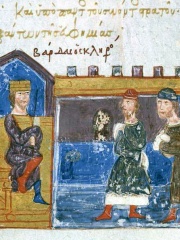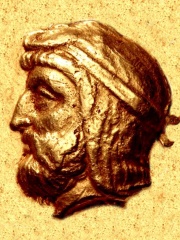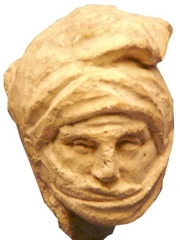





The Most Famous
MILITARY PERSONNELS from Turkey
This page contains a list of the greatest Turkish Military Personnels. The pantheon dataset contains 2,058 Military Personnels, 32 of which were born in Turkey. This makes Turkey the birth place of the 12th most number of Military Personnels behind Italy, and Ukraine.
Top 7
The following people are considered by Pantheon to be the most legendary Turkish Military Personnels of all time. This list of famous Turkish Military Personnels is sorted by HPI (Historical Popularity Index), a metric that aggregates information on a biography’s online popularity.

1. Bardas Skleros (1000 - 991)
With an HPI of 57.79, Bardas Skleros is the most famous Turkish Military Personnel. His biography has been translated into 17 different languages on wikipedia.
Bardas Skleros (Greek: Βάρδας Σκληρός) or Sclerus was a Byzantine general who led a wide-scale Asian rebellion against Emperor Basil II during the years 976 to 979.

2. Artabazos II (-400 - -360)
With an HPI of 57.34, Artabazos II is the 2nd most famous Turkish Military Personnel. His biography has been translated into 22 different languages.
Artabazos II (in Greek Ἀρτάβαζος) (fl. 389 – 328 BC) was a Persian general and satrap of Hellespontine Phrygia. He was the son of the Persian satrap of Hellespontine Phrygia Pharnabazus II, and younger kinsman (most probably nephew) of Ariobarzanes of Phrygia who revolted against Artaxerxes II around 356 BC. His first wife was an unnamed Greek woman from Rhodes, sister of the two mercenaries Mentor of Rhodes and Memnon of Rhodes. Towards the end of his life, he became satrap of Bactria for Alexander the Great.

3. Sosthenes of Macedon (-400 - -277)
With an HPI of 56.94, Sosthenes of Macedon is the 3rd most famous Turkish Military Personnel. His biography has been translated into 23 different languages.
Sosthenes (Greek Σωσθένης; died 277 BC) was a Macedonian general who may have been a king of the Antipatrid dynasty. During the reign of Lysimachus he was his governor in Asia Minor. Sosthenes was elected King by the Macedonian army, but he may or not have reigned as king. Appointed as strategos he may have declined the title of king as he had no royal connections. During his reign, he faced invading Galatians, Antigonus II Gonatas and other rivals. He defeated Bolgius, one of the earliest invading Galatian leaders but was soon faced with the invasion of Brennus in the summer of 279 BC. Antigonus II Gonatas tried to invade Macedonia from Asia in 278 but was beaten by Sosthenes.

4. Artabazos I of Phrygia (-600 - -500)
With an HPI of 56.53, Artabazos I of Phrygia is the 4th most famous Turkish Military Personnel. His biography has been translated into 23 different languages.
Artabazos (Ancient Greek: Ἀρτάβαζος; fl. 480 BC - 455 BC) was a Persian general in the army of Xerxes I, and later satrap of Hellespontine Phrygia (now northwest Turkey) under the Achaemenid dynasty, founder of the Pharnacid dynasty of satraps. He was the son of Pharnaces, who was the younger brother of Hystaspes, father of Darius I. Artabazos was therefore a first cousin of the great Achaemenid ruler Darius I.

5. Gainas (400 - 401)
With an HPI of 55.86, Gainas is the 5th most famous Turkish Military Personnel. His biography has been translated into 23 different languages.
Gainas (Greek: Γαϊνάς) was a Gothic leader who served the Eastern Roman Empire as magister militum during the reigns of Theodosius I and Arcadius. Gainas began his military career as a common foot-soldier, but later commanded the barbarian contingent of Theodosius' army against the usurper Eugenius in 394. Under the command of Gainas, a man of "no lineage", was the young Alaric of the Balti dynasty. In 395, during the Revolt of Alaric I, Stilicho sent him with his troops, under the cover of strengthening the armies of the East, to depose the prefect Rufinus, who was hostile to Stilicho. Gainas murdered Rufinus, but the eunuch Eutropius, who was likewise Stilicho's enemy, gained power. Gainas remained mostly unrewarded by the influential eunuch, which increased his resentment. In 399 he finally rose in stature by replacing magister militum Leo. This was after the latter failed to quell the insurrection of the Ostrogoths in Asia Minor, led by the chieftain Tribigild, who was also hostile to Eutropius. Gainas too failed to put down the invasions; according to some sources, Gainas was conspiring with Tribigild in order to effect the downfall of Eutropius. After suffering repeated failures against the Ostrogoths, who continued devastating the provinces of Asia Minor, Gainas advised Arcadius to accept Tribigild's terms, which included the death of Eutropius. Gainas then showed his true colors, openly joining Tribigild with all his forces; he forced Arcadius to sign a treaty whereby the Goths would be allowed to settle in Thrace, entrusted with the defense of that frontier against the barbarians beyond the Danube. Gainas proceeded to install his forces in Constantinople, where he ruled for several months. He attempted in effect to copy the success of Stilicho in the West and posed a danger to the survival of the Eastern Roman Empire. He deposed all the anti-Goth officials and had Eutropius executed, though he had previously only been banished; after the intervention of St. John Chrysostom the others were spared. While a somewhat competent military commander, the zealous Arian Gainas was patently unable to administer a city of 200–400,000 whose Greco-Roman populace intensely resented barbarian Goths and Arian Christians. Gainas' compromises with Tribigild led to rumors that he had colluded with Tribigild, his kinsman; when he returned to Constantinople in 400, riots broke out. He attempted to evacuate his soldiers but even then the citizens of Constantinople managed to trap and kill 7,000 armed Goths. In response, Gainas and his forces attempted to flee back across the Hellespont, but their rag-tag ad hoc fleet was met and destroyed by another Goth in Imperial service, Fravitta, who was subsequently made consul for 401 but was later accused of treason and executed as well. After this battle, Gainas fled across the Danube and was caught by the Huns under Uldin. Gainas was killed, and his head was sent by Uldin to Arcadius c. 400 as a diplomatic gift. After the revolt, Arcadius erected the Column of Arcadius, on which friezes depicted his triumph over Gainas. Gainas' usurpation is the subject of the Egyptian Tale and might also be the subject of the speech On Imperial Rule by Synesius of Cyrene who may have represented an anti-barbarian faction within the Byzantine nobility. Herwig Wolfram, the historian of the Goths, notes that the death of Gainas marks an end to the relatively pluralistic Gothic tribal development with independent warbands: "thereafter only two ethnogeneses were possible: that of the Roman Goths within the empire and that of the Hunnic Goths at its doorstep".

6. Mundus (450 - 536)
With an HPI of 53.57, Mundus is the 6th most famous Turkish Military Personnel. His biography has been translated into 22 different languages.
Mundus or Mundo (Greek: Μοῦνδος; Moundos, Latin: Mundo; died 536) was a Barbarian commander of Gepid, Hun, and/or Gothic origins. He appears to have been the son of the Gepid king Giesmus. In the early 500s he commanded a group of bandits in Pannonia, eventually allying himself to the Ostrogothic king Theodoric the Great. After Theodoric's death in 526, Mundus entered Byzantine service under emperor Justinian I, fighting in the Balkans, defending Justinian during the Nika riots, and fighting in the first stage of the Gothic War, during which he died in 536.

7. Tatikios (1100 - 1099)
With an HPI of 53.46, Tatikios is the 7th most famous Turkish Military Personnel. His biography has been translated into 22 different languages.
Tatikios or Taticius (Greek: Τατίκιος, c. 1048 - died after 1110) was an Eastern Roman general of Turkish origin during the reign of Alexios I Komnenos. His name is also rendered as Tetigus, Tatizius, Tatitius, Tatic, or Tetig.
People
Pantheon has 7 people classified as Turkish military personnels born between 600 BC and 1100. Of these 7, none of them are still alive today. The most famous deceased Turkish military personnels include Bardas Skleros, Artabazos II, and Sosthenes of Macedon.
Deceased Turkish Military Personnels
Go to all RankingsBardas Skleros
1000 - 991
HPI: 57.79
Artabazos II
400 BC - 360 BC
HPI: 57.34
Sosthenes of Macedon
400 BC - 277 BC
HPI: 56.94
Artabazos I of Phrygia
600 BC - 500 BC
HPI: 56.53
Gainas
400 - 401
HPI: 55.86
Mundus
450 - 536
HPI: 53.57
Tatikios
1100 - 1099
HPI: 53.46

